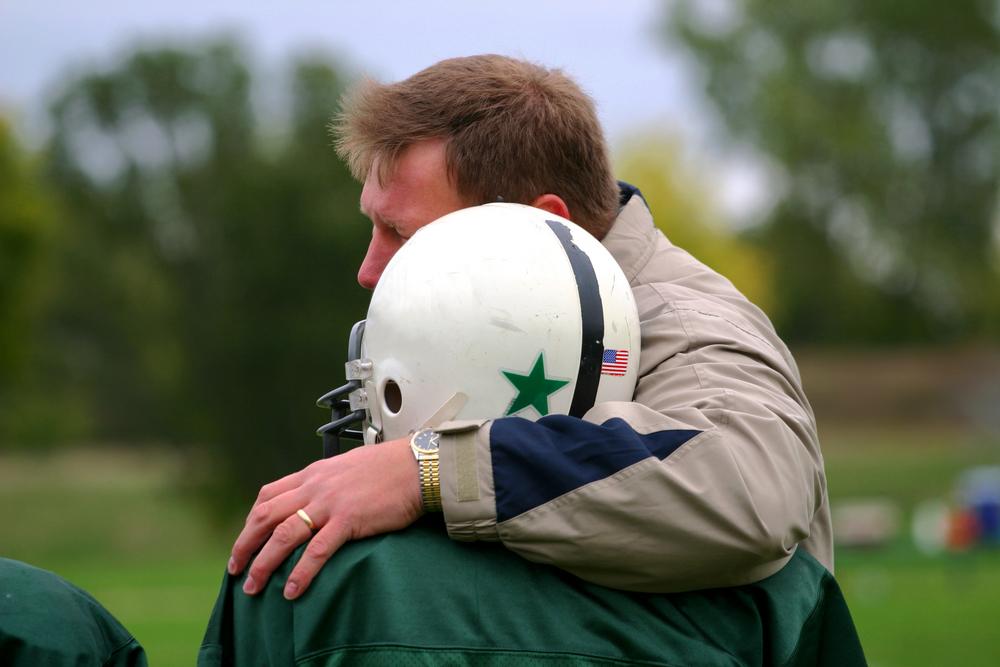 Creating the team culture you want can be tricky: Every small action you take or conversation you have contributes to the culture as much as any result from a competition or the work you put in at practice. So how do you purposefully create a healthy team environment that makes sport fun and meaningful for everyone?
Creating the team culture you want can be tricky: Every small action you take or conversation you have contributes to the culture as much as any result from a competition or the work you put in at practice. So how do you purposefully create a healthy team environment that makes sport fun and meaningful for everyone?
As TrueSport Expert Betsy Butterick points out, the stories we tell become the culture that we keep. Butterick, a coach and communication specialist, explains how athletes themselves can help create team culture through their words and actions.
What exactly is team culture?
“A strong team culture is when players and coaches collaboratively can be invited to create an environment that is suitable for growth,” says Butterick. “That includes elements like psychological safety, social contracts, and rules that everyone agrees on.”
It’s also about asking questions like the following:
- How do we want to treat each other in this shared space?
- How do we want to address issues before they become problems?
- What standards are we setting for each other?
- What does accountability look like?
Why is team culture so complicated?
If you’re a high school athlete, you’re on a sports team for a maximum of four years. That means there’s constant turnover, and every year, there are going to be shifts in culture simply because some people will leave as new athletes join the team. That means change is possible, which can be good. But it also means that maintaining a strong and healthy team culture takes constant effort and work on the part of both the coach and the athletes. “You’re having to reinvent, re-establish, or re-integrate your culture continuously,” Butterick says.
Understand confirmation bias and the role it plays in culture
To begin to understand how easy team culture can be shifted by the stories you tell and words you say, consider confirmation bias. Confirmation bias creates a narrative about different people or circumstances, and it can set expectations for a certain type of team culture. While that narrative is sometimes based in fact, it’s often the result of language and conversation choices that aren’t truly accurate depictions of the team’s culture. Used often enough, they can create a culture that’s less than optimal.
Imagine this, says Butterick: You’re a new recruit to a team, and a senior member is showing you around. You ask about the coach, and she tells you that he’s great, but he can be a little defensive sometimes. At your first practice, you catch him speaking defensively several times, and it makes you nervous to confront him about a problem with your training schedule because you assume he’ll be defensive about that. You feel resentful that his defensiveness is making life difficult for you on the new team.
While the coach may indeed have some issues with defensiveness, you may also be experiencing confirmation bias. “Our brains are meaning-making machines,” says Butterick. “It’s easier for our brain to make associations between different times in our life, similar contexts, and similar people to make meaning out of things versus spending time understanding new contexts. Because you heard that the coach was defensive, your brain noticed examples that confirmed previous information. Would you have felt that way if you hadn’t talked to the senior?”
This is important when it comes to team culture because it is easy to say things in casual conversation—about coaches, teammates, or even yourself—that have a significant ripple effect. Simple statements like, ‘He’s always late,’ or ‘He never can make the penalty shot,’ can have deep impacts on people and cause your teammates to develop these confirmation biases.
Confirmation bias can also be used with positive comments, but even that can be damaging, says Butterick. For example, when an athlete is considered to be ‘great under pressure’ and that piece of information is shared over and over, the athlete may experience a lot of anxiety around performance because the expectations are so high.
“In order to break that cycle, we have to actively look for the opposite thing to be true,” says Butterick. “In the example about the defensive coach, think about a time when you said something to the coach and he didn’t respond defensively, and was instead curious or receptive. Catching and challenging confirmation bias is a great start in creating a healthy team culture.”
Become Aware of Issues within the Current Team Culture
 “Awareness is a prerequisite for change,” says Butterick. If you don’t know what the current team culture is like because you’ve never reflected on it or thought about how it could be improved, you won’t be able to change it. Start by having a conversation with your teammates, or even with your coach, about the current state of your team’s culture and where there is room for improvement, as well as where things are going well.
“Awareness is a prerequisite for change,” says Butterick. If you don’t know what the current team culture is like because you’ve never reflected on it or thought about how it could be improved, you won’t be able to change it. Start by having a conversation with your teammates, or even with your coach, about the current state of your team’s culture and where there is room for improvement, as well as where things are going well.
As you’re doing this exercise, try to remain in the present rather than going back to stories from years ago, unless the issues are still relevant today. “We tend to get stuck in our old stories,” she adds. “I try to ask athletes questions about when something happened that made you feel a certain way. Often, I find that something may have been true at one point, but that’s no longer the case. We need to challenge these current stories that we have.”
When Butterick interviews athletes, she tries to elicit both positive and negative stories from them. We tend to start with the negatives, so she tries to ensure that for every negative, she also asks for a positive. “I like to ask the question, ‘What else could be true?’ to get athletes thinking deeper,” she says.
Ask How You Can Control the Team Culture
As student-athletes, often there are a lot of things that you won’t be able to control, like practice times or the competition schedule. But you likely have more control than you realize when it comes to creating a healthy team culture, says Butterick. “It’s important to ask yourself what is within your control,” she says. “When an athlete shares a negative situation, I often will ask if there is anything that the athlete could have done proactively or in response to that scenario to try to improve the quality of the situation. The onus is often put on the coach to fix a situation, and in many cases, the coach doesn’t even know the problem exists.”
For example, an athlete may be uncomfortable with the team uniforms. Perhaps the shorts feel too short or the tank top feels too revealing, but there were no other options offered. The coach may not be aware of how the athlete is feeling, but as their teammate, you could advocate for more uniform options.
Don’t be Afraid to Ask for Clarification
To develop a strong team culture, it’s helpful to have athletes and coaches on the same page. And often, the reason they aren’t is because of a lack of clarity. Butterick has two simple questions that athletes can ask their coach in these situations: “Can you clarify that?” and “Can you help me understand?”
Asking those questions opens up a conversation. “It’s not accusatory, it’s just asking for greater clarity,” says Butterick. ”
Remember that Everyone Sees Situations Through a Different Lens
You likely have had a situation where you thought a friend was angry at you, but it turned out that they were simply upset with a teacher or had a fight with a parent. The same thing is true of your teammates: What felt like a great practice or game for you may have been their worst day on the field. So, despite sharing an experience, you didn’t share the same feelings about that experience.
Understanding this helps you think about team culture differently because it makes you more aware of how your teammates may be viewing a situation. “Yes, we all have a shared experience at practice, but we’re all having our own unique experience of that shared context,” says Butterick. “When practice is over and you go to the locker room, what are you choosing to talk about from practice? Are you talking about how hard you noticed someone working? Are you talking about how exciting that one drill was? How proud you are of other people? Or are you talking about the one or two moments that weren’t great?”
You don’t always have to force your teammates to be positive in order to have a healthy team culture. But you should be solution-oriented, says Butterick. “If you highlight a negative about practice, I would encourage you to also talk about solutions,” she says. “Can you be the person who doesn’t solely complain, but also is intentional about talking about solutions or possibilities? A strong team culture doesn’t shy away from the problems on the team, but it does focus on improving them.”
Check in on Your Own Stories
Beyond team culture, you can look at the stories you tell yourself about who you are as an athlete. If you have a bad game, do you look for other teammates to blame, focus on bad calls the referee made, or get angry at the coach? “We often look for stories that will absolve us of responsibility or the need to take a more critical, uncomfortable look at ourselves and our own contribution to a situation,” Butterick says. “It’s important to ask ourselves, ‘What else is true?'”
The answer to that will bring you back to looking for things that are within your control. What can you do to change the outcome or the situation?
Butterick recommends using conversations with teammates or trusted adults, journalling, or even just some quiet thinking time to work through these questions and thoughts. Creating a strong team culture isn’t a one-time exercise: It’s going to be a constant work in progress, and the more attention you give it, the stronger it will be. Make sure to also bring these conversations to your teammates rather than trying to create and implement all of these strategies alone. These conversations should be happening regularly in an open, safe environment where everyone feels comfortable sharing their view for crafting a better team culture.
___________________________
Takeaway
Team culture is created by action and behavior, but it’s also created by the language that we use and the stories that we tell about ourselves and others. Become aware of how you’re talking about yourself, your teammates, your coaches, and your performances. A strong, positive team culture can be greatly influenced just by shifting the way you speak—and that can lead to better performances for your team.



